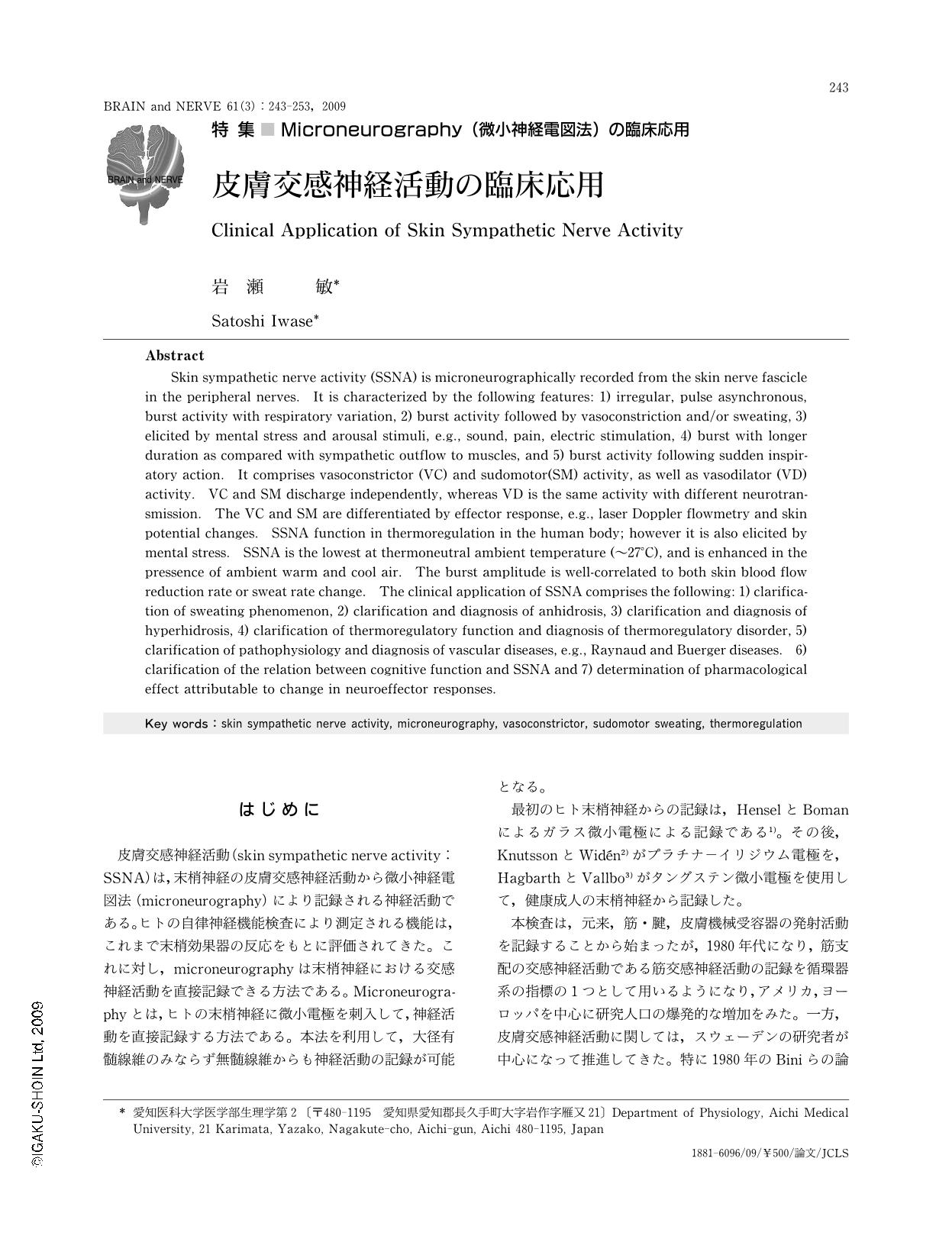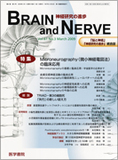Japanese
English
- 有料閲覧
- Abstract 文献概要
- 1ページ目 Look Inside
- 参考文献 Reference
はじめに
皮膚交感神経活動(skin sympathetic nerve activity:SSNA)は,末梢神経の皮膚交感神経活動から微小神経電図法(microneurography)により記録される神経活動である。ヒトの自律神経機能検査により測定される機能は,これまで末梢効果器の反応をもとに評価されてきた。これに対し,microneurographyは末梢神経における交感神経活動を直接記録できる方法である。Microneurographyとは,ヒトの末梢神経に微小電極を刺入して,神経活動を直接記録する方法である。本法を利用して,大径有髄線維のみならず無髄線維からも神経活動の記録が可能となる。
最初のヒト末梢神経からの記録は,HenselとBomanによるガラス微小電極による記録である1)。その後,KnutssonとWiden2)がプラチナ-イリジウム電極を,HagbarthとVallbo3)がタングステン微小電極を使用して,健康成人の末梢神経から記録した。
本検査は,元来,筋・腱,皮膚機械受容器の発射活動を記録することから始まったが,1980年代になり,筋支配の交感神経活動である筋交感神経活動の記録を循環器系の指標の1つとして用いるようになり,アメリカ,ヨーロッパを中心に研究人口の爆発的な増加をみた。一方,皮膚交感神経活動に関しては,スウェーデンの研究者が中心になって推進してきた。特に1980年のBiniらの論文4,5)は,最初に皮膚交感神経活動の詳細を記載したが,このころの『Journal of Physiology』誌は著者の掲載をアルファベット順に行っており,この論文はおそらくWallinが中心になり書かれたと考えられる。日本では,1980年代に間野の研究室において小川,菅屋との協力のもとに筆者らが体温調節との関連で皮膚交感神経活動の研究を進め,2004年,筆者が菅屋の研究室に移籍して日本での研究が発展した。
臨床的に皮膚交感神経活動の応用を推進したのは,山梨大学の塩澤,新藤のグループで,各種神経疾患において皮膚交感神経活動を測定し,その価値を高めた。また,テキサス大学サウスウェスト医療センター運動環境医学研究所のCrandallのグループは循環調節と体温調節の相互作用についての研究を行っている。
現在でもスウェーデンのイェーテボリ大学サールグレン病院のWallin, Elamのグループは,皮膚交感神経活動の研究において中心的役割を果たしている。
本稿においては,皮膚交感神経活動の記録法,性質,筋交感神経活動との違い,同定法について述べ,各種特殊環境下における皮膚交感神経活動の変化を解析し,その異常によって生ずる病態について述べるが,microneurography全体については,Manoらの総説を参照されたい6-9)。
Abstract
Skin sympathetic nerve activity (SSNA) is microneurographically recorded from the skin nerve fascicle in the peripheral nerves. It is characterized by the following features: 1) irregular,pulse asynchronous,burst activity with respiratory variation,2) burst activity followed by vasoconstriction and/or sweating,3) elicited by mental stress and arousal stimuli,e.g.,sound,pain,electric stimulation,4) burst with longer duration as compared with sympathetic outflow to muscles,and 5) burst activity following sudden inspiratory action. It comprises vasoconstrictor (VC) and sudomotor(SM) activity,as well as vasodilator (VD) activity. VC and SM discharge independently,whereas VD is the same activity with different neurotransmission. The VC and SM are differentiated by effector response,e.g.,laser Doppler flowmetry and skin potential changes. SSNA function in thermoregulation in the human body; however it is also elicited by mental stress. SSNA is the lowest at thermoneutral ambient temperature (~27℃),and is enhanced in the pressence of ambient warm and cool air. The burst amplitude is well-correlated to both skin blood flow reduction rate or sweat rate change. The clinical application of SSNA comprises the following: 1) clarification of sweating phenomenon,2) clarification and diagnosis of anhidrosis,3) clarification and diagnosis of hyperhidrosis,4) clarification of thermoregulatory function and diagnosis of thermoregulatory disorder,5) clarification of pathophysiology and diagnosis of vascular diseases,e.g.,Raynaud and Buerger diseases. 6) clarification of the relation between cognitive function and SSNA and 7) determination of pharmacological effect attributable to change in neuroeffector responses.

Copyright © 2009, Igaku-Shoin Ltd. All rights reserved.


